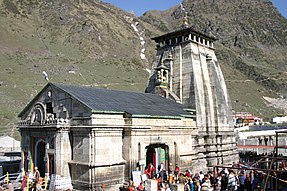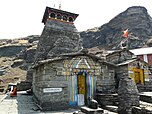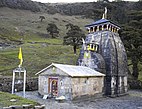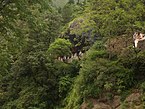 Kēdārnāth Mandir (Kedarnath Temple) (केदारनाथ मंदिर) is a Hindu temple dedicated to Lord Shiva. It is on the Garhwal Himalayan range near the Mandakini river in Kedarnath, Uttarakhand in India. Due to extreme weather conditions, the temple is open only between the end of April (Akshaya Tritriya) to Kartik Purnima (the autumn full moon, usually November). During the winters, the vigrahas (deities) from Kedarnath temple are brought to Ukhimath and worshipped there for six months. Lord Shiva is worshipped as Kedarnath, the 'Lord of Kedar Khand', the historical name of the region.
Kēdārnāth Mandir (Kedarnath Temple) (केदारनाथ मंदिर) is a Hindu temple dedicated to Lord Shiva. It is on the Garhwal Himalayan range near the Mandakini river in Kedarnath, Uttarakhand in India. Due to extreme weather conditions, the temple is open only between the end of April (Akshaya Tritriya) to Kartik Purnima (the autumn full moon, usually November). During the winters, the vigrahas (deities) from Kedarnath temple are brought to Ukhimath and worshipped there for six months. Lord Shiva is worshipped as Kedarnath, the 'Lord of Kedar Khand', the historical name of the region.
The unstable temple is not directly accessible by road and has to be reached by a 18 kilometres (11 mi) uphill trek from Gaurikund. Pony and manchan service is available to reach the structure. The temple was built by Pandavas and revived by Adi Sankaracharya and is one of the twelve Jyotirlingas, the holiest Hindu shrines of Shiva. It is one of the 275 Paadal Petra Sthalams, expounded in Tevaram. Pandavas were supposed to have pleased Shiva by doing penance in Kedarnath. The temple is one of the four major sites in India's Chota Char Dham
pilgrimage of Northern Himalayas. This temple is the highest among the
12 Jyotirlingas.Kedarnath was the worst affected area during the 2013 flash floods in North India.
The temple complex, surrounding areas and Kedarnath town suffered
extensive damage, but the temple structure did not suffer any "major"
damage, apart from a few cracks on one side of the four walls which was
caused by the flowing debris from the higher mountains. A large rock
among the debris acted as a barrier, protecting the temple from the
flood. The surrounding premises and other buildings in market area were
heavily damaged
Temple and past significance
The temple, at an height of 3,583 m (11,755 ft), 223 km from Rishikesh, on the shores of Mandakini river, a tributary of Ganga, is an impressive stone edifice of unknown date. The structure is believed to have been constructed in the 8th century CE, when Adi Shankara visited. The present structure is on a site adjacent to where Pandavas are believed to have built the temple. It has one Garbhagriha and a Mandapa, and stands on a plateau surrounded by snow clad mountain and glaciers. In front of the temple, directly opposite to the inner shrine, is a Nandi statue carved out of rock.Legend
Popularly-narrated legend holds that subsequent to the Kurukshetra war of the epic Mahabharata, the Pandavas on the advice of the god Krishna and other sages wished to atone for their sins of fratricide and Brāhmanahatya, committed by them during the war by seeking pardon from the god Shiva and also pray for his blessings before attaining salvation. But Shiva was not willing to meet them since he was annoyed with them for the unjust events of the war. He, therefore, avoided meeting them at Kashi and went incognito as the bull Nandi to Guptakashi. But Pandavas pursued him to Guptakashi and recognized him in the disguised form of Nandi. When Bhima, the second Pandava brother tried to hold the bull by its tail and hind legs, Nandi vanished from Guptakashi, into the ground (into a cave for hiding), but reappeared later as Shiva in five different forms namely, hump at Kedarnath, face at Rudranath, arms at Tungnath, navel and stomach at Madhyamaheshwar and the locks at Kalpeshwar.[7][8][9][10][11]A triangular shaped rock is worshiped in Garbhagriha of the temple. Surrounding Kedarnath, there are many symbols of the Pandavas. Raja Pandu died at Pandukeshwar. The tribals here perform a dance called "Pandav Nritya". [12] The mountain top where the Pandavas went to Swarga, is known as "Swargarohini", which is located off Badrinath. When Darmaraja was leaving for Swarga, one of his fingers fell on the earth. At that place, Dharmaraj installed a Shiva Linga, which is the size of the thumb. To gain Mashisharupa, Shankara and Bheema fought with maces. Bheema was struck with remorse. He started to massage Lord Shankara’s body with ghee. In memory of this event, even today, this triangular Shiva JyotirLinga is massaged with ghee. Water and Bel leaves are used for worship.
When Nara-Narayan went to Badrika village and started the worship of Parthiva, Shiva appeared before them. Nara-Narayan wished that, for the welfare of the humanity, Shiva should remain there in his original form. Granting their wish, in the snow-clad Himalayas, in a place called Kedar, Mahesha himself stayed there as a Jyoti. Here, He is known as Kedareshwara.
Inside temple[edit]
The head priest (Raval) of the Kedarnath temple belongs to the Veerashaiva community from Karnataka.[15] However, unlike in Badrinath temple, the Raval of Kedarnath temple does not perform the pujas. The pujas are carried out by Raval's assistants on his instructions. The Raval moves with the deity to Ukhimath during the winter season. There are five main priests for the temple, and they become head priests for one year by rotation. The present (2013) Raval of Kedarnath temple is Shri Vageesha Lingacharya.[15] Shri Vageesh Ligaacharya who belongs from the Village Banuvalli of Taluka Harihar of Davanagere district in Karnataka. During Pooja of Lord Shiva at Kedaranath the mantras will be pronounced in the Kannada language. This has been a custom from hundreds of years.[16]
Administration
The temple was included in the Uttar Pradesh state government Act No. 30/1948 as Act no. 16,1939, which came to be known as Shri Badarinath and Shri Kedarnath Mandir Act. The committee nominated by the state government administers both temples. The act was modified in 2002, which provisioned adding additional committee members including Government officials and a Vice chairman.There are a total of seventeen members in the board; three selected by the Uttaranchal Legislative Assembly, one member each by the Zilla Parishads of Garhwa, Tehri, Chamoli and Uttarkashi, and ten members nominated by the state government.[18] On the religious side, there is a Rawalji (chief priest) and three other priests: Nayab Rawal, Acharya/Dharmadhikari and Vedpathi. The administrative structure of the temple consists of a chief executive officer who executes the orders from the state government. A deputy chief executive officer, two OSDs, an executive officer, an account officer, a temple officer and a publicity officer assist the chief executive officer.[20]
Way to kedarnath temple in early winter
2013 flash floods[edit]

Rear view of the Kedarnath Temple in the aftermath of the flood

Front view of the Kedarnath Temple in the aftermath of the flood
Another theory for the temple not being destroyed is because of its construction.[21][22][23][24] Although the temple withstood the severity of the floods, the complex and surrounding area were destroyed, resulting in the death of hundreds of pilgrims and locals. Shops and hotels in Kedarnath were destroyed and all roads were broken. People took shelter inside the temple for several hours, until the Indian Army airlifted them to safer places.[15] The Uttarakhand Chief Minister announced that the Kedarnath shrine would remain closed for a year for clearing the debris.
The experts, who were asked by the Archaeological Survey of India to examine the condition of the foundation in wake of the floods have arrived at the conclusion that there was no danger to the temple.The IIT Madras experts visited the temple thrice for the purpose. Non-destructive testing instruments that do not disturb the structure of the temple were used by the IIT-team for assessing the health of the structure, foundation and walls. They have submitted their interim report that the temple is stable and there was no major danger.[25][26][27]
- Kedarnath temple photos
-
 1880s photo of Kedarnath temple
1880s photo of Kedarnath temple
-
 Kedarnath Temple - It is one of the Twelve Jyotirlingas
Kedarnath Temple - It is one of the Twelve Jyotirlingas
-
 Kedarnath Temple - Kedarnath - Night view
Kedarnath Temple - Kedarnath - Night view








Post a Comment
Post a Comment